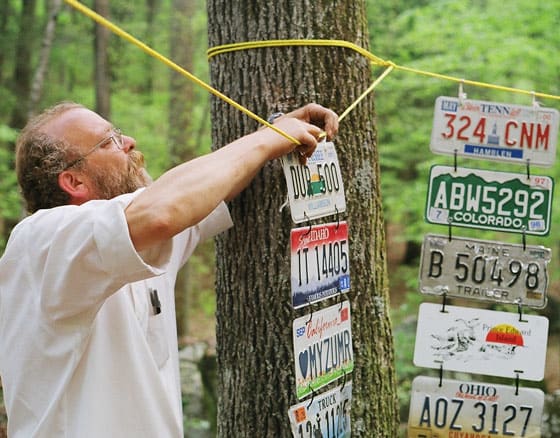As far as sporting events go, long-distance running may not exactly be the most exciting to watch, but a marathon is capable of testing what an athlete is made of like perhaps no other. In the captivating and thrilling documentary The Barkley Marathons: The Race That Eats Its Young, this idea is driven home while watching men and women attempt to complete the gruelling 100-mile course through unforgiving Tennessee terrain in 2012.
The details of the idiosyncratic race itself are bizarre enough to warrant committing to film. As created by Gary "Laz" Cantrell and a largely unseen guy who goes by the handle "Raw Dog," competitors are carefully selected and then asked to pay a small fee that includes donating a flannel shirt to Cantrell in this 2012 iteration. They are eventually roused by the blowing of a conch at an unannounced time, and then race around a vaguely defined and constantly evolving course. They rip pages corresponding to their jersey number from paperbacks placed at various points along the way to prove their completion.
Since the first Barkley Marathon in 1986, only a handful of people have actually managed to finish. In fact, for nearly the entire first decade of its existence, no one completed the course. We're introduced to frontrunners, outliers and someone who's been selected as the annual sacrifice for being in way over his head. Brett Maune is poised to become the first two-time finisher, and has an eye on the course record. Promising newcomer Jared Campbell wisely elects to stay close to Brett and get the lay of the land from a veteran.
It doesn't take long for people to start dropping out. Some are disappointed at not being able to accomplish their goals, while others are delighted to even complete one of the five "loops" (or laps) that make up the marathon. Given how rare it is that anyone even finishes, it's downright exhilarating when this one actually turns into a tight race at the end, and there's real inspiration to be found in how one particular runner is able to cope with extreme damage to his feet in his effort to succeed.
Throughout it all, though, there's the affable presence of Cantrell. Outlining what parts of the course always prove to be the most treacherous (there are sections with names like Testicle Spectacle and Rat Jaw) and how the genesis of the marathon is tied to the escape of Martin Luther King Jr.'s assassin James Earl Ray from the nearby prison, he appears to view the event as a labour of love. And why not? He helped create something entirely unique that has earned respect over the years due to its extreme degree of difficulty. It's truly something to behold, in all its excruciating glory.
(Independent)The details of the idiosyncratic race itself are bizarre enough to warrant committing to film. As created by Gary "Laz" Cantrell and a largely unseen guy who goes by the handle "Raw Dog," competitors are carefully selected and then asked to pay a small fee that includes donating a flannel shirt to Cantrell in this 2012 iteration. They are eventually roused by the blowing of a conch at an unannounced time, and then race around a vaguely defined and constantly evolving course. They rip pages corresponding to their jersey number from paperbacks placed at various points along the way to prove their completion.
Since the first Barkley Marathon in 1986, only a handful of people have actually managed to finish. In fact, for nearly the entire first decade of its existence, no one completed the course. We're introduced to frontrunners, outliers and someone who's been selected as the annual sacrifice for being in way over his head. Brett Maune is poised to become the first two-time finisher, and has an eye on the course record. Promising newcomer Jared Campbell wisely elects to stay close to Brett and get the lay of the land from a veteran.
It doesn't take long for people to start dropping out. Some are disappointed at not being able to accomplish their goals, while others are delighted to even complete one of the five "loops" (or laps) that make up the marathon. Given how rare it is that anyone even finishes, it's downright exhilarating when this one actually turns into a tight race at the end, and there's real inspiration to be found in how one particular runner is able to cope with extreme damage to his feet in his effort to succeed.
Throughout it all, though, there's the affable presence of Cantrell. Outlining what parts of the course always prove to be the most treacherous (there are sections with names like Testicle Spectacle and Rat Jaw) and how the genesis of the marathon is tied to the escape of Martin Luther King Jr.'s assassin James Earl Ray from the nearby prison, he appears to view the event as a labour of love. And why not? He helped create something entirely unique that has earned respect over the years due to its extreme degree of difficulty. It's truly something to behold, in all its excruciating glory.
